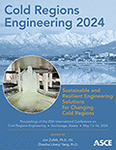Seasonal Frost Impact on Liquefaction-Induced Lateral Spreading
Publication: Cold Regions Engineering 2024: Sustainable and Resilient Engineering Solutions for Changing Cold Regions
ABSTRACT
Liquefaction-induced lateral spreading can cause significant deformations and damage in structures, such as bridges, highways, and pipelines, including the broad cold regions. This paper assesses how a seasonally occurring ground crust would affect liquefaction-induced lateral spreading. One-dimensional, plane-strain analyses with shear beam boundary conditions were performed with OpenSeesPL, using the soil profile at the Slana River site and a pressure-dependent multiple yield surface constitutive model for liquefaction simulation. Four cases, including the base case (no seasonal frost) and cases with seasonal frost of 0.3, 1, or 2 m thick, were considered. The East–West motion recorded at Pump station #10 of the Trans-Alaska Pipeline System during the 2002 Denali earthquake was used as the base input. The results, including the time histories of acceleration, excess pore water pressure ratio, shear strain, and ground lateral spreading for selected depths, are presented. The results show that seasonal frost has a minor impact on the lateral spread displacement induced by liquefaction for the study site with a silty gravelly fill of relatively low permeability. Moreover, a parametric study was carried out to analyze the impact of the permeability of the fill on the triggering of liquefaction and ground surface lateral displacement. The medium sand layer almost entirely liquefies when the permeability of the fill is equal to or less than 10−5 m/s, resulting in larger lateral spreading displacements.
Get full access to this chapter
View all available purchase options and get full access to this chapter.
REFERENCES
Alaska Department of Transportation and Public Facilities (AKDOT&PF). (2005). Geotechnical study Northway Airport improvements. Prepared for Central Region Materials, Alaska Department of Transportation and Public Facilities.
Alaska Department of Transportation and Public Facilities (AKDOT&PF). (2015). “Final Structural Foundation Engineering Report - Tok Cut-Off Highway MP 75.6 Slana River Bridge #0654.” Federal Project 0A12004 / State Project No. 63567.
Araujo, W., & Ledezma, C. (2020). Factors That Affect Liquefaction-Induced Lateral Spreading in Large Subduction Earthquakes. Applied Sciences, 10(18), 6503.
Bardet, J. P., & Kapuskar, M. (1993). Liquefaction Sand Boils in San Francisco during 1989 loma prieta earthquake. Journal of Geotechnical Engineering, 119(3), 543–562.
Bartlett, Steven F., & Youd, T. L. (1992). Case histories of lateral spreads caused by the 1964 Alaska earthquake. In. Hamada, Masanori, ed; O'Rourke, T. D. Case studies liquefaction and lifeline performance during past earthquakes: United states case studies. Buffalo, N.Y, U.S. National Center for Earthquake Engineering Research (NCEER), p.1–127.
Bunn, M., Gillins, D., & Hall, K. (2015). Assessing Lateral Spread Hazards in Areas Prone to Great and Long-Duration Earthquakes. https://earthquake.usgs.gov/cfusion/external_grants/reports/G14AP00067.pdf
Cubrinovski, M., Robinson, K., Taylor, M., Hughes, M., & Orense, R. (2012). Lateral spreading and its impacts in urban areas in the 2010–2011 Christchurch earthquakes. New Zealand Journal of Geology and Geophysics, 55(3), 255–269.
Elgamal, A., Yang, Z., & Parra, E., (2002). “Computational modeling of Cyclic Mobility and Post-Liquefaction Site Response.” Journal of Soil Dynamics and Earthquake Engineering, 22(4): 259–271.
Haeri, S. M., & Rajabigol, M. (2023). Effects of liquefaction-induced lateral spreading on piles, an overview of physical modeling. Soil Dynamics and Earthquake Engineering, 173, 108111.
Hamada, M., Isoyama, R., & Wakamatsu, K. (1996). Liquefaction-induced ground displacement and its related damage to lifeline facilities. Soils and Foudations, 36(Special), 81–97.
Harp, E. L., Jibson, R. W., Kayen, R. E., Keefer, D. K., Sherrod, B. L., Carver, G. A., Collins, B. D., Moss, R. E. S., & Sitar, N. (2003). Landslides and liquefaction triggered by the M 7.9 Denali Fault earthquake of 3 November 2002. GSA Today, 13(8), 4.
Jia, J., & Springerlink (Online Service). (2018). Soil Dynamics and Foundation Modeling: Offshore and Earthquake Engineering (p. 740). Springer International Publishing.
Kostadinov, M. V., & Yamazaki, F. (2001). Detection of soil liquefaction from strong motion records. Earthquake Engineering & Structural Dynamics, 30(2), 173–193.
Mazzoni, S., McKenna, F., & Fenves, G.L. (2006). Open System for Earthquake Engineering Simulation User Manual. Pacific Earthquake Engineering Research Center, University of California, Berkeley, CA.
Parra, E. (1996). “Numerical modeling of liquefaction and lateral ground deformation including cyclic mobility and dilation response in soil systems.” Ph.D. Dissertation, Rensselaer Polytechnic Institute, Troy, NY
Plafker, G., & Berg, H. C. (1994). The Geology of Alaska. Geological Society of America, 1068.
Siemon Wm. Muller. (1946). Permafrost and Related Engineering Problems: ABSTRACT. AAPG Bulletin, 30.
Ueng, T., Wu, M., Lin, C., & Yu, R. (2000). Pore water pressure changes in sands under earthquake loading. https://www.iitk.ac.in/nicee/wcee/article/1285.pdf
Yang, Z., Ge, X., Still, B., & Paris, A. (2012). Frozen Soil Lateral Resistance for the Seismic Design of Highway Bridge Foundations. Draft Final Report, prepared for Alaska University Transportation Center and the State of Alaska Department of Transportation and Public Facilities, Dept. of Civil Engineering, University of Alaska Anchorage.
Yang, Z.J., Ebert, D., & Zhao, Y., (2023). Evaluation of liquefaction induced lateral spread from recent Alaska Earthquakes (Report number: FHWA-AK-RD-4000(200)HFHWY00198). Prepared for Alaska Department of Transportation and Public Facilities.
Youd, T. (2014). Ground failure investigations following the 1964 Alaska Earthquake: Ground Failure Investigations Following the 1964 Alaska Earthquake (p. 10). https://datacenterhub.org/resources/11986/download/10NCEE-000651.pdf
Information & Authors
Information
Published In
History
Published online: May 9, 2024
ASCE Technical Topics:
- Climates
- Cold regions engineering
- Continuum mechanics
- Displacement (mechanics)
- Dynamics (solid mechanics)
- Earth materials
- Engineering mechanics
- Environmental engineering
- Fills
- Frost
- Geomaterials
- Geomechanics
- Geotechnical engineering
- Permeability (soil)
- Pressure (type)
- Seasonal variations
- Soil liquefaction
- Soil mechanics
- Soil properties
- Solid mechanics
- Structural mechanics
- Water pressure
Authors
Metrics & Citations
Metrics
Citations
Download citation
If you have the appropriate software installed, you can download article citation data to the citation manager of your choice. Simply select your manager software from the list below and click Download.
